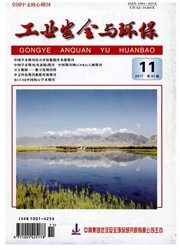

 中文摘要:
中文摘要:
为有效去除水体污染物磺胺类抗生素(Sulfonamides antibiotics,SAs),采用高级氧化紫外/双氧水(UV/H_2O_2)和紫外/过硫酸盐(UV/PS)工艺降解磺胺甲基嘧啶(sulfamerazine,SM1)。研究表明,紫外与氧化剂(H_2O_2,PS)联用可显著提高去除率,其反应符合拟一级动力学模型。磺胺甲基嘧啶的去除率在一定范围随着氧化剂H_2O_2和PS的浓度升高而升高;磺胺甲基嘧啶初始质量浓度越大,反应速率越小。两种工艺降解磺胺甲基嘧啶最大去除率均发生在pH=3。NaCl会抑制两种工艺对目标污染物的降解,而适当的NaHCO_3可促进其降解反应的进行。腐植酸的存在对两种工艺降解污染物均会产生抑制作用。
 英文摘要:
英文摘要:
In order to effectively remove sulfonamides antibiotics in aqueous solution,the advanced oxidation ultraviolet / hydrogen peroxide and ultraviolet / persulfate technology are used to degrade sulfamerazine. Research shows that it can obviously improve the removal rate when adding oxidizers H_2O_2 and PS,and degradation process conforms first order kinetics model. Within a certain concentration of oxidizers H_2O_2 and PS,the removal rate of sulfamerazine will be improved with the increase of oxidant concentration; the reaction rate decreases with the increase of sulfamerazine initial concentration; when pH = 3,the maximum removal rate all happens by these two kinds of sulfamerazine degradation processes. NaCl has inhibiting effect on these two technologies,but appropriate NaHCO_3 has acceleration effect on it. Humic acids has inhibiting effect on the two kinds of degradation technologies.
 同期刊论文项目
同期刊论文项目
 同项目期刊论文
同项目期刊论文
 Adsorption of perchlorate from aqueous solution by the calcination product of Mg/(Al–Fe) hydrotalcit
Adsorption of perchlorate from aqueous solution by the calcination product of Mg/(Al–Fe) hydrotalcit Impact of pre-ozonation on disinfection by-product formation and speciation from chlor(am)ination of
Impact of pre-ozonation on disinfection by-product formation and speciation from chlor(am)ination of Characteristics of C-, N-DBPs formation from algal organic matter: Role of molecular weight fraction
Characteristics of C-, N-DBPs formation from algal organic matter: Role of molecular weight fraction Adsorption of perchlorate from aqueous solutions by anion exchange resins: Effects of resin properti
Adsorption of perchlorate from aqueous solutions by anion exchange resins: Effects of resin properti Influence of hydrophobic/hydrophilic fractions of extracellular organic matters of Microcystis aerug
Influence of hydrophobic/hydrophilic fractions of extracellular organic matters of Microcystis aerug Nanoscale iron hydroxide-doped granular activated carbon (Fe-GAC) as a sorbent for perchlorate in wa
Nanoscale iron hydroxide-doped granular activated carbon (Fe-GAC) as a sorbent for perchlorate in wa Photochemical degradation of ciprofloxacin in UV and UV/H2O2 process: kinetics, parameters, and prod
Photochemical degradation of ciprofloxacin in UV and UV/H2O2 process: kinetics, parameters, and prod Removal of Microcystis aeruginosa by potassium ferrate (VI): Impacts on cells integrity, intracellul
Removal of Microcystis aeruginosa by potassium ferrate (VI): Impacts on cells integrity, intracellul Effect of chlorine dioxide on cyanobacterial cell integrity, toxin degradation and disinfection by-p
Effect of chlorine dioxide on cyanobacterial cell integrity, toxin degradation and disinfection by-p Radical induced degradation of acetaminophen with Fe3O4 magnetic nanoparticles as heterogeneous acti
Radical induced degradation of acetaminophen with Fe3O4 magnetic nanoparticles as heterogeneous acti Characterization of algal organic matters of Microcystis aeruginosa: Biodegradability, DBP formation
Characterization of algal organic matters of Microcystis aeruginosa: Biodegradability, DBP formation Removal of perchlorate in water by calcined MgAl-CO3Removal of Perchlorate in Water by CalcinedMgAl-
Removal of perchlorate in water by calcined MgAl-CO3Removal of Perchlorate in Water by CalcinedMgAl- Bacterial reduction of highly concentrated perchlorate: Kinetics andinfluence of co-existing electro
Bacterial reduction of highly concentrated perchlorate: Kinetics andinfluence of co-existing electro Degradation of the antiepileptic drug carbamazepine upon different UV-based advanced oxidation proce
Degradation of the antiepileptic drug carbamazepine upon different UV-based advanced oxidation proce 期刊信息
期刊信息
